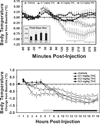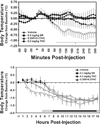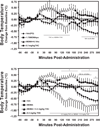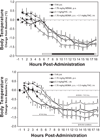Δ9-Tetrahydrocannabinol attenuates MDMA-induced hyperthermia in rhesus monkeys
- PMID: 22138434
- PMCID: PMC3258357
- DOI: 10.1016/j.neuroscience.2011.11.040
Δ9-Tetrahydrocannabinol attenuates MDMA-induced hyperthermia in rhesus monkeys
Abstract
Background: Cannabis is commonly consumed by Ecstasy (3,4-methylenedioxymethamphetamine; MDMA) users, including as an intentional strategy to manipulate the drug experience. The most active psychoactive constituent in cannabis, Δ(9)-tetrahydrocannabinol (THC), and other drugs with partial or full agonist activity at the CB(1) receptor, produces a reduction of body temperature in rodents. Reports show that administration of THC can attenuate temperature increases caused by MDMA in mice or rats; however, a recent study in humans shows that THC potentiates MDMA-induced temperature elevations. Relatively little scientific evidence on the thermoregulatory effects of THC in monkeys is available.
Methods: The body temperature of male rhesus macaques was recorded after challenge with THC (0.1-0.3 mg/kg, i.m.) or combined challenge of THC with the CB(1) receptor antagonist SR141716 (Rimonabant; 0.3 mg/kg, i.m.) or combined challenge of THC (0.1, 0.3 mg/kg, i.m.) with MDMA (1.78 mg/kg p.o.) using minimally-invasive, implanted radiotelemetry techniques.
Results: THC reduced the body temperature of monkeys in a dose-dependent manner with the nadir observed 3-5 h post-injection; however, an attenuation of normal circadian cooling was also produced overnight following dosing. Hypothermia induced by THC (0.3 mg/kg, i.m.) was prevented by Rimonabant (0.3 mg/kg, i.m.). Finally, 0.3 mg/kg THC (i.m.) attenuated the elevation of body temperature produced by MDMA for about 4 h after oral dosing.
Conclusions: As with rodents THC produces a robust and lasting decrement in the body temperature of rhesus monkeys; this effect is mediated by the CB(1) receptor. THC also protects against the immediate hyperthermic effects of MDMA in monkeys in a dose-dependent manner. Nevertheless, a paradoxical attenuation of circadian cooling overnight after the THC/MDMA combination cautions that longer-term effects may be critical in assessing risks for the recreational user of cannabis in combination with MDMA.
Copyright © 2011 IBRO. Published by Elsevier Ltd. All rights reserved.
Figures




Similar articles
-
THC Prevents MDMA Neurotoxicity in Mice.PLoS One. 2010 Feb 10;5(2):e9143. doi: 10.1371/journal.pone.0009143. PLoS One. 2010. PMID: 20174577 Free PMC article.
-
Chronic administration of THC prevents the behavioral effects of intermittent adolescent MDMA administration and attenuates MDMA-induced hyperthermia and neurotoxicity in rats.Neuropharmacology. 2011 Dec;61(8):1183-92. doi: 10.1016/j.neuropharm.2011.07.002. Epub 2011 Jul 13. Neuropharmacology. 2011. PMID: 21763331 Free PMC article.
-
MDMA attenuates THC withdrawal syndrome in mice.Psychopharmacology (Berl). 2007 Jul;193(1):75-84. doi: 10.1007/s00213-007-0772-5. Epub 2007 Mar 27. Psychopharmacology (Berl). 2007. PMID: 17387458
-
A review of the mechanisms involved in the acute MDMA (ecstasy)-induced hyperthermic response.Eur J Pharmacol. 2004 Oct 1;500(1-3):3-13. doi: 10.1016/j.ejphar.2004.07.006. Eur J Pharmacol. 2004. PMID: 15464016 Review.
-
The role of monoamines in the changes in body temperature induced by 3,4-methylenedioxymethamphetamine (MDMA, ecstasy) and its derivatives.Br J Pharmacol. 2010 Jul;160(5):1029-44. doi: 10.1111/j.1476-5381.2010.00722.x. Br J Pharmacol. 2010. PMID: 20590597 Free PMC article. Review.
Cited by
-
Explication of CB1 receptor contributions to the hypothermic effects of Δ9-tetrahydrocannabinol (THC) when delivered by vapor inhalation or parenteral injection in rats.Drug Alcohol Depend. 2020 Sep 1;214:108166. doi: 10.1016/j.drugalcdep.2020.108166. Epub 2020 Jul 16. Drug Alcohol Depend. 2020. PMID: 32717503 Free PMC article.
-
Δ(9)Tetrahydrocannabinol impairs reversal learning but not extra-dimensional shifts in rhesus macaques.Neuroscience. 2013 Apr 3;235:51-8. doi: 10.1016/j.neuroscience.2013.01.018. Epub 2013 Jan 16. Neuroscience. 2013. PMID: 23333671 Free PMC article.
-
Inhaled delivery of Δ(9)-tetrahydrocannabinol (THC) to rats by e-cigarette vapor technology.Neuropharmacology. 2016 Oct;109:112-120. doi: 10.1016/j.neuropharm.2016.05.021. Epub 2016 May 30. Neuropharmacology. 2016. PMID: 27256501 Free PMC article.
-
Cannabidiol fails to reverse hypothermia or locomotor suppression induced by Δ(9) -tetrahydrocannabinol in Sprague-Dawley rats.Br J Pharmacol. 2015 Apr;172(7):1783-91. doi: 10.1111/bph.13024. Epub 2015 Jan 23. Br J Pharmacol. 2015. PMID: 25425111 Free PMC article.
-
Clinical and Preclinical Evidence for Functional Interactions of Cannabidiol and Δ9-Tetrahydrocannabinol.Neuropsychopharmacology. 2018 Jan;43(1):142-154. doi: 10.1038/npp.2017.209. Epub 2017 Sep 6. Neuropsychopharmacology. 2018. PMID: 28875990 Free PMC article. Review.
References
-
- Banks ML, Sprague JE, Kisor DF, Czoty PW, Nichols DE, Nader MA. Ambient temperature effects on 3,4-methylenedioxymethamphetamine-induced thermodysregulation and pharmacokinetics in male monkeys. Drug metabolism and disposition: the biological fate of chemicals. 2007;35:1840–1845. - PubMed
-
- Bowyer JF, Young JF, Slikker W, Itzak Y, Mayorga AJ, Newport GD, Ali SF, Frederick DL, Paule MG. Plasma levels of parent compound and metabolites after doses of either d-fenfluramine or d-3,4-methylenedioxymethamphetamine (MDMA) that produce long-term serotonergic alterations. Neurotoxicology. 2003;24:379–390. - PubMed
-
- Clark JD, Baldwin RL, Bayne KA, Brown MJ, Gebhart GF, Gonder JC, Gwathmey JK, Keeling ME, Kohn DF, Robb JW, Smith OA, Steggarda J-AD, Vandenbergh JG, White WJ, Williams-Blangero S, VandeBerg JL. Guide for the Care and Use of Laboratory Animals. Washington D.C.: Institute of Laboratory Animal Resources, National Research Council; 1996. p. 125.
-
- Clingerman KJ, Summers L. Development of a body condition scoring system for nonhuman primates using Macaca mulatta as a model. Lab Anim (NY) 2005;34:31–36. - PubMed
Publication types
MeSH terms
Substances
Grants and funding
LinkOut - more resources
Full Text Sources
Medical
Research Materials

